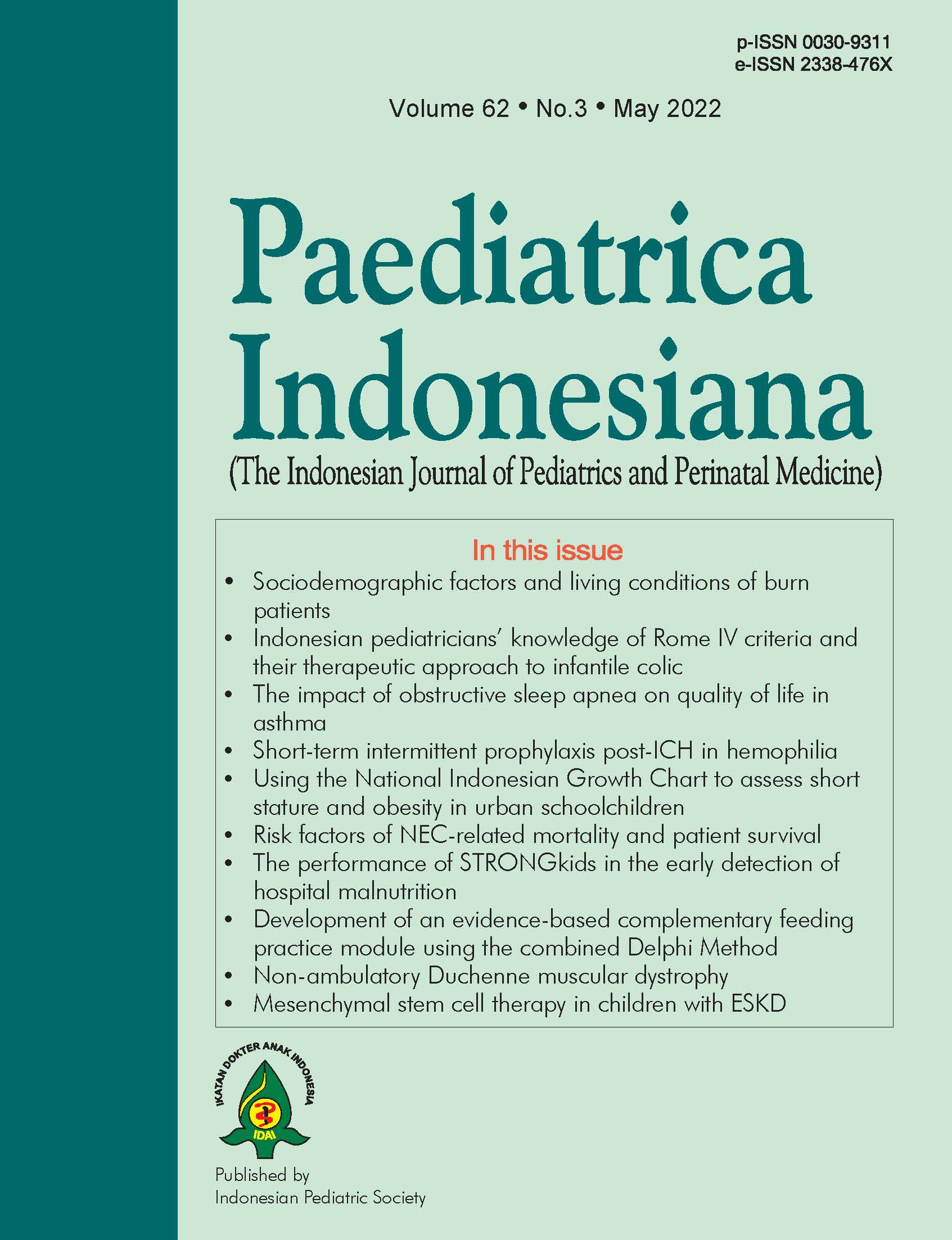Short-term intermittent prophylaxis post-intracranial hemorrhage in children with hemophilia
Abstract
Background Intracranial hemorrhage (ICH) is one of the major bleeding events causing mortality and long-term morbidity in children with hemophilia, especially those who receive on-demand therapy.
Objective To evaluate the outcome of children with hemophilia after ICH receiving short-term intermittent prophylactic treatment.
Methods This retrospective study was conducted in the Department of Child Health, Dr. Cipto Mangunkusumo Hospital, Jakarta. Children £18 years of age with hemophilia presenting with ICH between 2015-2020 were included. We recorded patients’ demographics, type and severity of hemophilia, the presence of factor VIII (FVIII) inhibitor, brain CT scan, treatment, and outcomes of these patients. Patients who received short-term intermittent prophylaxis using clotting factor concentrate (CFC) post-ICH episodes were observed for ICH recurrence.
Results There were 19 episodes of ICH experienced by 18 patients, consisting of 16 patients with hemophilia A and 2 with hemophilia B. Patients’ median age was 4 years (range 0-16 years). Hemophilia was classified as severe in 13 patients, moderate in 4 patients, and mild in 1 patient. Thirteen episodes were preceded by head trauma. The most common clinical manifestation was seizures (13.2%). The most common type of ICH was subdural hematoma. Two patients died and 2 patients had neurological sequelae during hospitalization. The median dose of short-term intermittent prophylaxis using CFC (n=16) was 20 IU/kg of FVIII twice a week and 30 IU/kg of FIX twice a week, for a median duration of 8 weeks (range 5-12 weeks). One patient who did not adhere to the prophylaxis regimen had recurrent ICH at a similar location 6 months after the first episode.
Conclusion Our findings suggest that short-term intermittent prophylaxis is important to prevent the recurrence of ICH in children with hemophilia.
References
2. Haque Q, Abuduaini Y, Li H, Wen J, Wu X, Feng X. Intracranial hemorrhage in children with inherited bleeding disorders: a single center study in China. J Pediatr Hematol Oncol. 2019;41:207-9. DOI: https://doi.org/10.1097/MPH.0000000000001358.
3. Chalmers EA, Alamelu J, Collins PW, Mathias M, Payne J, Richards M, et al. Intracranial haemorrhage in children with inherited bleeding disorders in the UK 2003-2015: a national cohort study. Haemophilia. 2018;24:641–7. DOI: https://doi.org/10.1111/hae.13461.
4. Bladen M, Main E, Khair K, Hubert N, Koutoumanou E, Liesner R. The incidence, risk and functional outcomes of intracranial haemorrhage in children with inherited bleeding disorders at one haemophilia center. Haemophilia. 2016;22:556–63. DOI: https://doi.org/10.1111/hae.12938.
5. Chozie NA, Gatot D, Windiastuti E, Handryastuti S. Perdarahan intrakranial pada hemofilia: karakteristik, tata laksana, dan luaran. Sari Pediatri. 2011;13:250–6. DOI: https://doi.org/10.14238/sp13.4.2011.250-6.
6. Andersson NG, Auerswald G, Barnes C, Carcao M, Dunn AL, Fijnvandraat K, et al. Intracranial haemorrhage in children and adolescents with severe haemophilia A or B - the impact of prophylactic treatment. Br J Haematol. 2017;179:298–307. DOI: https://doi.org/10.1111/bjh.14844.
7. Witmer C, Presley R, Kulkarni R, Soucie JM, Manno CS, Raffini L. Associations between intracranial haemorrhage and prescribed prophylaxis in a large cohort of haemophilia patients in the United States. Br J Haematol. 2011;152:211–6. DOI: https://doi.org/10.1111/j.1365-2141.2010.08469.x.
8. Srivastava A, Santagostino E, Dougall A, Kitchen S, Sutherland M, Pipe SW, et al. WFH Guidelines for the management of hemophilia, 3rd edition. Haemophilia. 2020;26:1–158. DOI: https://doi.org/10.1111/hae.14046.
9. Cho JY, Lee WS, Park YS, Lee SH, Koh JS. Clinical characteristics and prognostic factors in hemophiliacs with intracranial hemorrhage: a single-center, retrospective experience. Indian J Hematol Blood Transfus. 2016;32:488–93. DOI: https://doi.org/ 10.1007/s12288-016-0637-3.
10. Greenberg MS. Handbook of neurosurgery. 8th edition. New York: Thieme; 2016. p.227-30.
11. García Sánchez P, Molina Gutiérrez MÁ, Martín Sánchez J, Inisterra Viu L, García García S, Rivas Pollmar MI, et al. Head trauma in the haemophilic child and management in a paediatric emergency department: descriptive study. Haemophilia. 2018;24:e187–93. DOI: https://doi.org/10.1111/hae.13526.
12. Witmer CM. Low mortality from intracranial haemorrhage in paediatric patients with haemophilia. Haemophilia. 2015;21:e359–63. DOI: https://doi.org/10.1111/hae.12716.
13. Miles BS, Anderson P, Agostino A, Golomb MR, Achonu C, Blanchette V, et al. Effect of intracranial bleeds on the neurocognitive, academic, behavioural and adaptive functioning of boys with haemophilia. Haemophilia. 2012;18:229–34. DOI: https://doi.org/10.1111/j.1365-2516.2011.02632.x.
14. Manco-Johnson MJ, Lundin B, Funk S, Peterfy C, Raunig D, Werk M, et al. Effect of late prophylaxis in hemophilia on joint status: a randomized trial. J Thromb Haemost. 2017;15:2115–24. DOI: https://doi.org/10.1111/jth.13811.
15. Gringeri A, Lundin B, von Mackensen S, Mantovani L, Mannucci PM, ESPRIT Study Group. A randomized clinical trial of prophylaxis in children with hemophilia A (the ESPRIT Study). J Thromb Haemost. 2011;9:700–10. DOI: https://doi.org/10.1111/j.1538-7836.2011.04214.x.
16. Chozie NA, Primacakti F, Gatot D, Setiabudhy RD, Tulaar ABM, Prasetyo M. Comparison of the efficacy and safety of 12?month low?dose factor VIII tertiary prophylaxis vs on?demand treatment in severe haemophilia A children. Haemophilia. 2019;25:633-9. DOI: https://doi.org/10.1111/hae.13770
17. Kementerian Kesehatan Republik Indonesia. Keputusan Menteri Kesehatan Republik Indonesia Nomor HK.01.07/MENKES/243/2021 tentang pedoman nasional pelayanan kedokteran tata laksana hemofilia. Jakarta: Kementerian Kesehatan Republik Indonesia; 2021.
18. Castaman G, Linari S. Prophylactic versus on-demand treatments for hemophilia: advantages and drawbacks. Expert Rev Hematol. 2018;11:567–76. DOI: https://doi.org/10.1080/17474086.2018.1486704.
19. Tang L, Wu R, Sun J, Zhang X, Feng X, Zhang X, et al. Short-term low-dose secondary prophylaxis for severe/moderate haemophilia A children is beneficial to reduce bleed and improve daily activity, but there are obstacle in its execution: a multi-centre pilot study in China. Haemophilia. 2013;19:27–34. DOI: https://doi.org/10.1111/j.1365-2516.2012.02926.x.
Copyright (c) 2022 Novie Amelia Chozie, Fitri Primacakti, Made Citra Saraswati, Damayanti Sekarsari

This work is licensed under a Creative Commons Attribution-NonCommercial-ShareAlike 4.0 International License.
Authors who publish with this journal agree to the following terms:
Authors retain copyright and grant the journal right of first publication with the work simultaneously licensed under a Creative Commons Attribution License that allows others to share the work with an acknowledgement of the work's authorship and initial publication in this journal.
Authors are able to enter into separate, additional contractual arrangements for the non-exclusive distribution of the journal's published version of the work (e.g., post it to an institutional repository or publish it in a book), with an acknowledgement of its initial publication in this journal.
Accepted 2022-05-24
Published 2022-05-24













